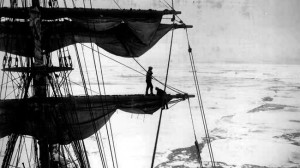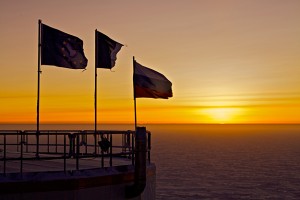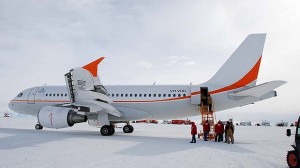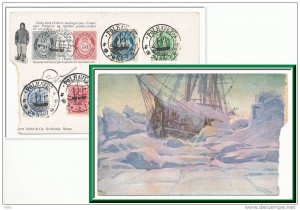Arctic Shipping and Native Hunters
As Arctic shipping grows, Native hunters aim to protect marine mammals
Alex DeMarban | Mar 14, 2012
Alaska Native subsistence hunters hoping to protect whales, polar bears and other marine mammals have joined forces to offer input on proposed shipping rules being developed for the nation’s Arctic frontier.
Representatives from groups including the Alaska Eskimo Whaling Commission, the Inuit Circumpolar Council, and the Ice Seal Committee formed a coalition on Tuesday to present a unified voice recommending rules and more infrastructure in the barely regulated Arctic Ocean, officials said.
The unprecedented effort comes amid a rise in the number of boats steaming through the Bering Strait, a trend expected to grow as the increasingly ice-free waters expand shipping opportunities and Shell prepares to explore the region for oil.
Major proposals the group hopes to influence include a U.S. Coast Guard effort to create international shipping lanes through the strait and anInternational Polar Code that could set broad rules for maritime travel through the fragile Arctic.
Main food source
The still-unnamed coalition will focus on ensuring food security for dozens of villages that depend on marine mammals and fish, said Jimmy Stotts, president of the Inuit Circumpolar Council of Alaska. Protecting those animals means protecting Native culture and traditions, such as families hunting together or making skin boats for whale hunts.
“A high percent of daily food in the Inuit society comes from hunting and gathering, higher than people realize,” said Stotts, who is originally from Barrow.
The new coalition also includes the Eskimo Walrus Commission, theAlaska Nanuuq Commission that protects polar bears and regional tribal groups such as the Association of Village Council Presidents based in Bethel’s largely Yup’ik region.
Some large organizations, such as the North Slope Borough, have offered ideas, Stotts said. But generally, voices of Native hunters have not been heard.
Representatives with the group convened in Anchorage early this week to begin making plans. U.S. Coast Guard presenters at the meeting said themulti-year effort to create shipping lanes has run into one significant obstacle — finding the proper Russian authorities to meet with.
The number of vessels crossing the strait — 53 miles wide at its narrowest point — has doubled in recent years. Some 400 trips were recorded in 2011, with bigger vessels often sailing down the Russian coast and smaller tugs and barges — often with supplies for Alaska Native villages — traveling along the busier U.S. side.
The area could get busier soon. Shell plans to bring 33 ships north to begin exploratory drilling in the Beaufort and Chukchi seas this summer, meaning scores more trips as those vessels and support boats steam back and forth.
That’s a concern for coastal villages. Ten communities across Alaska’s Arctic hunt bowhead whales. Nearly three dozen hunt walrus. Many more rely on seals and fish.
Rising bowhead whale population
More boat traffic means more ecological risk for the Arctic, where animals and ships can be squeezed together in limited areas such as “leads,” natural lanes formed amid thick sea ice. Shoreside gatherings of marine mammals are also vulnerable. Among those areas is a new summer walrus haulout near the village of Point Lay, said Craig George, a biologist with the North Slope Borough’s wildlife management department.
Chief concerns for all animals include toxic spills and increased boat strikes. Industrial noise might also mask whale communication or stress bowhead and beluga whales, as a study of right whales has found, he said. Bowheads are easily frightened when they’re on the move. “If they’re migrating, they’re extremely shy,” George said. “Ask any hunter. One knock of an oar with a skin boat and boom, they’re gone.”
Bowhead numbers have risen over the years, with estimates putting the population above 13,000. Hunters want to keep it that way, said George.
Any effort needs approval from the International Maritime Organization (IMO). And without Russian participation, the IMO likely will reject any scheme for the Bering Strait as insufficient, said U.S. Coast Gard Capt. Adam Shaw. In that case, regulations wouldn’t apply to Russian’s side of the strait, and that would limit protections for whales and other animals, which ignore international boundaries.
Shaw said the Coast Guard is making progress on the study, assembling recommendations from the public into a draft report that should be available for another round of public input late this year. Then the Coast Guard plans to travel to numerous villages with the preliminary report, Shaw said.
“We’re coming back to you and saying, ‘This is what we heard, this is what we think. Are we correct?’ ” Shaw said.
Where are the Russians?
Coast Guard Cmdr. James Houck said things are moving ahead except for one snag: Finding someone in the Russian Ministry of Transport to work with has taken “far longer” than expected. Houck said Russia will eventually be at the planning table, but he hopes it doesn’t take a huge accident for that to happen.
“I have no doubt that we will be able to reach agreement if we are able to find a point of contact within the Russian government where we can interact,” he said. “Either we haven’t made the right people aware of our needs, or they’re so busy they haven’t made time for that person to work with us yet.”
One big fear is a spill in Russia that spreads to U.S. waters, especially if a large tanker with lots of oil runs aground. So it’s important to increase oversight of shipping along the Russian coast as well, said Martin Robards, with the Wildlife Conservation Society, which helped organize the meeting.
Shaw, with the Coast Guard, told Native hunters not to expect a navigation center on Little Diomede soon. Many people have suggested such a facility — picture an air-traffic control center for boats — on the U.S. island halfway across the strait to Russia.
But the strait’s ship traffic doesn’t warrant such a large investment right now. It’s rising but still small compared to other areas. For example, one day of traffic in the Port of San Francisco is equal to a year of traffic in the Bering Strait.
Instead, additional monitoring and tracking can be accomplished by installing such hardware as radio repeaters and transmitters to improve communication with ships, as well as enhanced tracking by satellites, he said.
As for the International Polar Code, a professor of Arctic Policy at the University of Alaska Fairbanks told the groups that Canada and Russia have set some standards for ships traveling through the Arctic. But the U.S. has no such requirements, said Lawson Brigham.
The International Maritime Organization is working on the code, though the effort is behind schedule. It could set guidelines on everything from ice-navigator training to special safety gear to proper ship design.
Stotts, with the Inuit Circumpolar Conference, said it’s too early to know what the coalition will recommend. But the discussion that will play out over the coming months could present new ideas and address existing ones, such as building the Arctic’s first deepwater port and establishing a communication system requiring oceangoing vessels to notify nearby villages of their plans.
http://www.alaskadispatch.com/article/arctic-shipping-grows-native-hunters-aim-protect-marine-mammals
Antarctic Guide
info@antarcticguide.com
Twitter: AntarcticGuide




